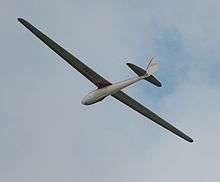EoN Olympia
| EoN Olympia | ||
|---|---|---|
 | ||
| Olympia being bungee-launched at Camphill, Great Hucklow, Derbyshire | ||
| Role | Glider | |
| Manufacturer | Elliotts of Newbury | |
| Designer | Hans Jacobs | |
| First flight | January 1947 | |
| Number built | 150 | |
|
|} The Eon Olympia was a glider produced from 1947 by Elliotts of Newbury. Design and developmentElliotts had been asked in 1945 by Chilton Aircraft Ltd to make one set of wings for the Chilton Olympia, a glider that had been developed in pre-war Germany as the DFS Olympia Meise. This had been designed by Hans Jacobs and selected as the glider for the 1940 Summer Olympics. The German drawings were not detailed and so entirely new drawings were made by Chilton that merely retained the Meise Olympia's aerodynamic shape. Otherwise it was a complete re-design and resulted in a stronger and heavier (+30 kg) aircraft. To maintain employment at their factory, Elliotts refused to sell the wing jigs that they had made for the prototype. Consequently, Chilton gave up all aircraft work, agreeing to sell to Elliotts the production rights, fuselage jigs, and work in hand on all Olympia gliders. Production of the Olympia (originally called Type 5) started in 1946 as a batch of 100, and the first flight was made in January 1947. Elliotts and their design consultants Aviation & Engineering Products Ltd made improvements to the original design before starting production. Marks 1, 2 and 3 were produced, mainly distinguishable by the landing gear. The Mark 1 had only a skid whereas the Olympia 2 had a built-in main wheel. The Eon Olympia 3's wheel was jettisonable after take off. The first batch of 100 was completed in 1947 but the market could not absorb such a large number, despite the low price of £425. Even by 1953, 40 of the first 100 Olympias were still unsold. Nevertheless, a second batch of 50 was built. Gliders from the second batch were still being offered for sale for £800 as late as 1957 in order to clear the stock, despite being below cost price. After building three marks of the Olympia, another improved version, called the EoN Olympia 4 was produced in 1954. This is regarded as being sufficiently different from the original as being a new type. This type in turn led to a succession of variants. Operational historyOn 24 August 1950 an Eon Olympia flown by Bill Bedford broke the British distance record by flying 310 km in 3:50 hr. On 2 May 1951 Bedford broke his record with a flight of 413 km from Farnborough to Newcastle. Olympias also broke height records on occasions, culminating in a flight by Gordon Rondel on 18 June 1960 in a thunderstorm to 9,321 m (30,580 ft) with gain of height of 8,870 m (29,100 ft), absolute National height and gain of height records. Variants Olympia 2 BBH/BGA834 at the Vintage Glider Rally at Camphill, 2011 Data from Ellison, 1971[1]
Specifications (Olympia 2)Data from The World's Sailplanes:Die Segelflugzeuge der Welt:Les Planeurs du Monde[2] General characteristics
Performance
See also
Notes
References
Further reading
External links
| ||